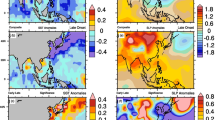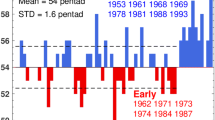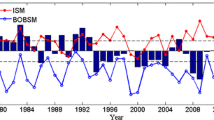Summary
Interannual variations of the summer monsoon onset over the South China Sea (SCS) have been studied using data from over seventeen years (1979–1995) of NMC global analysis and of Outgoing Longwave Radiation (OLR) observed with NOAA polar-orbitting satellites. It was found that the summer monsoon onset in the SCS occurs abruptly with a sudden change of zonal wind direction from easterly to westerly and an exploding development of deep convection in the whole SCS region in the middle of May.
Based on the criteria defined in this paper for the SCS summer monsoon onset, the average onset date over the SCS from 1979 to 1995 is around the fourth pentad of May. The airflow and general circulation over the SCS changes dramatically after the onset. The ridge of the subtropical high in the western Pacific in the lower troposphere weakens and retreats eastward from the SCS region with an establishment of westerly winds over the whole region. During the SCS monsoon onset, the most direct impact in the vicinity of the SCS are the equatorial westerlies in the Bay of Bengal through their eastward extension and northward movement. An indirect influence on the SCS onset is also caused by the enhancement of the Somali cross-equatorial flow and the vanishing Arabian High over the sea; the latter may be a signal for the SCS onset.
There are quite significant interannual variations in the SCS onset. In the years of a delayed onset, the most profound feature is that the easterly winds stay longer in the SCS than on average. Deep convection activities are suppressed. The direct cause is the abnormal existence of the western Pacific subtropical high over the SCS region. Moreover, compared to the average, the equatorial westerlies in the Bay of Bengal are also weaker in the years of a delayed onset. No significant changes for the cross-equatorial flow at 105 °E are observed for these years. It has also been found that the interannual variations of the SCS onset are closely related with the ENSO events. In the years of a delay, the Walker circulation is weaker, and the sea surface temperature (SST) anomalies in the western Pacific are negative.
Similar content being viewed by others
Author information
Authors and Affiliations
Additional information
Received April 14, 1997 Revised July 11, 1997
Rights and permissions
About this article
Cite this article
Xie, A., Chung, YS., Liu, X. et al. The Interannual Variations of the Summer Monsoon Onset overthe South China Sea. Theor Appl Climatol 59, 201–213 (1998). https://doi.org/10.1007/s007040050024
Issue Date:
DOI: https://doi.org/10.1007/s007040050024




